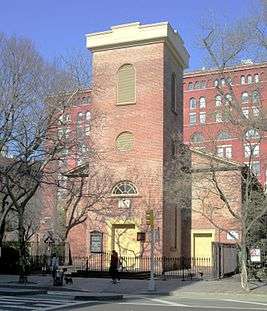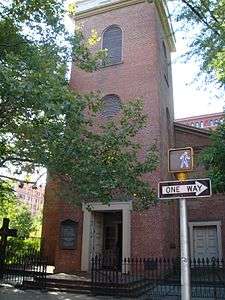Church of St. Luke in the Fields
Coordinates: 40°43′57″N 74°00′25″W / 40.7324°N 74.007°W

The Church of St. Luke in the Fields is an Episcopal church located at 487 Hudson Street between Christopher and Barrow Streets at the intersection of Grove Street in the Greenwich Village neighborhood of Manhattan, New York City. The church was constructed in 1821-22 and has been attributed to both John Heath, the building contractor, and James N. Wells.[1]
The church is affiliated with the St. Luke's School, an elementary school located on the same block. Both are located within the Greenwich Village Historic District, designated in 1969.[2]
History
The church was founded in 1820 on farmland[3] donated by Trinity Church, to accommodate the expansion of New York City northward into Greenwich Village.[2] The original church building was reminiscent of an English village church, with a square tower at one end, but made of brick and built in the Federal style.[2][4] It was part of a complex laid out by Clement Clarke Moore – who would serve as the church's first pastor[4][1] – which included adjoining stone row houses,[2] which the church rented out.[5] Greenwich Village at the time was a sanctuary for people fleeing the endemic diseases of the city proper, and the name of the new parish – St. Luke in the Fields – was chosen to evoke the pastoral quality of the area.[5]
When the surrounding neighborhood become predominantly poor and largely composed of immigrants in the late 1880s, the congregation moved north to West 141st Street, and St. Luke's became a chapel of Trinity Church, only regaining its independence in 1976 under rector Ledlie Laughlin.[2][4][1]
Other prominent rectors in the past have included John Murray Forbes, who helped to bring the Oxford Movement to the United States[4] and Edward Schlueter, who served from 1911 until the 1940s, and developed programs which served the community, such as children's summer camps. Schlueter also had the church sanctuary redesigned in high Medieval style.[4]
The church building was damaged by fire twice, in 1886 and on March 6, 1981. After the latter fire, which gutted the building,[4] it was reconstructed by Hugh Hardy of Hardy Holzman Pfeiffer Associates, who restored much of its original Federal style touches.[4] The reconstruction was completed in 1985.[2][1]
In 2000, the church received a Village Award from the Greenwich Village Society for Historic Preservation.[6]
Activism
For many years, the church distributed bread to the poor after the 10am service on Saturdays. This "Leake Dole of Bread" was provided for in the will of John Leake.[3]
Starting in the 1980s, the HIV/AIDS epidemic deeply affected the Village community, hitting the congregation hard.[1] The AIDS Project of St. Luke's was founded in 1987, providing Saturday dinner and weekend teas to tens of thousands of afflicted persons. One of the priests ministering to AIDS patients then was former actress Molly McGreevey.[7] St. Luke's is actively involved with the gay and lesbian community, participating with its own contingent at the annual Gay Pride March.[7] Every year, the church also holds a Festive Choral Evensong after the Pride March.[8]

Music
The choir of the church performs several concerts yearly, with a series of three concerts each spring season. In the past these concerts have included performances such as the New York premiere of Telemann's St. Matthew Passion, the Tenebrae settings of composer Richard Toensing and many other works. The choir has made several recordings. In addition to the choir, the church is known for its vigorous congregational singing. Mr. David Shuler is the organist and choirmaster of the church.
Gwen Gould, former music director of the School at St. Luke's was also the founder of the West Village Chorale, currently directed by Malcolm J. Merriweather. Until 2010, most of the Chorale's concerts were performed at the Church. They have currently moved to Judson Memorial Church at Washington Square Park.
The Orchestra of St. Luke's draws its name from the church.
Organ
The current organ at the church was installed in 1986 after the 1981 fire destroyed the previous organ. It is almost identical to the one that was destroyed, which had been installed in 1979, less than two years before the fire. Its keys are mechanical, though the stops operate electrically. It has 27 stops and 1,670 pipes.
In popular culture
References
Notes
- 1 2 3 4 5 Dunlap, David W. (2004). From Abyssinian to Zion: A Guide to Manhattan's Houses of Worship. New York: Columbia University Press. ISBN 0-231-12543-7., p.223
- 1 2 3 4 5 6 New York City Landmarks Preservation Commission; Dolkart, Andrew S. (text); Postal, Matthew A. (text) (2009), Postal, Matthew A., ed., Guide to New York City Landmarks (4th ed.), New York: John Wiley & Sons, ISBN 978-0-470-28963-1, p.52
- 1 2 Federal Writers' Project (1939), New York City Guide, New York: Random House, ISBN 0-403-02921-X (Reprinted by Scholarly Press, 1976; often referred to as WPA Guide to New York City), p.142
- 1 2 3 4 5 6 7 Gerardi, Donald F.M. "Church of St. Luke-in-the-Fields" in Jackson, Kenneth T., ed. (1995), The Encyclopedia of New York City, New Haven: Yale University Press, ISBN 0300055366, p.223
- 1 2 Burrows, Edwin G. & Wallace, Mike (1999), Gotham: A History of New York City to 1898, New York: Oxford University Press, ISBN 0-195-11634-8, pp.447-448
- ↑ "Past Village Award Winners". GVSHP.org. Retrieved 1 June 2015.
- 1 2 "History". Church of St. Luke in the Fields. 2010. Retrieved November 19, 2010.
- ↑ Stiffler, Scott (Jul 12, 2011). "'Queer Theology' Aims to Transform Christianity". EDGE Philadelphia. Retrieved July 14, 2011.
- ↑ "IMDB: Doubt (2008 film)," IMDB (Accessed 10 February 2011)
External links
| Wikimedia Commons has media related to Church of St. Luke in the Fields. |
- St. Luke in the Fields History
- StLukeintheFields.org
- StLukeSchool.org
- St. Luke's Chapel records at Trinity Wall Street Archives